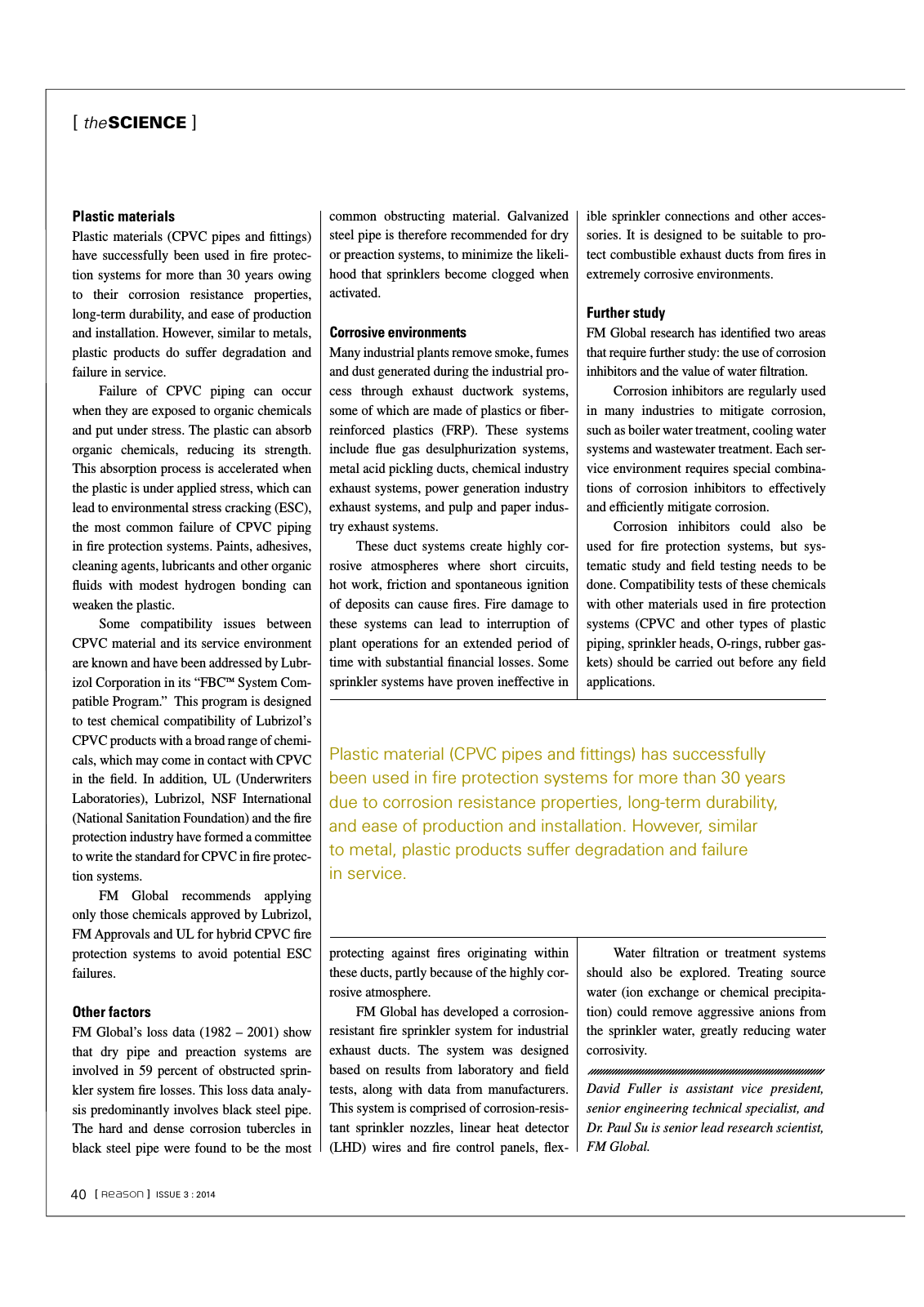Reason Magazin 2014Q3 Seite 40
Hinweis: Dies ist eine maschinenlesbare No-Flash Ansicht.Klicken Sie hier um zur Online-Version zu gelangen.
Inhalt
Plastic materials Plastic materials CPVC pipes and fittings have successfully been used in fire protec tion systems for more than 30 years owing to their corrosion resistance properties long term durability and ease of production and installation However similar to metals plastic products do suffer degradation and failure in service Failure of CPVC piping can occur when they are exposed to organic chemicals and put under stress The plastic can absorb organic chemicals reducing its strength This absorption process is accelerated when the plastic is under applied stress which can lead to environmental stress cracking ESC the most common failure of CPVC piping in fire protection systems Paints adhesives cleaning agents lubricants and other organic fluids with modest hydrogen bonding can weaken the plastic Some compatibility issues between CPVC material and its service environment are known and have been addressed by Lubr izol Corporation in its FBCTM System Com patible Program This program is designed to test chemical compatibility of Lubrizol s CPVC products with a broad range of chemi cals which may come in contact with CPVC in the field In addition UL Underwriters Laboratories Lubrizol NSF International National Sanitation Foundation and the fire protection industry have formed a committee to write the standard for CPVC in fire protec tion systems FM Global recommends applying only those chemicals approved by Lubrizol FM Approvals and UL for hybrid CPVC fire protection systems to avoid potential ESC failures Other factors FM Global s loss data 1982 2001 show that dry pipe and preaction systems are involved in 59 percent of obstructed sprin kler system fire losses This loss data analy sis predominantly involves black steel pipe The hard and dense corrosion tubercles in black steel pipe were found to be the most common obstructing material Galvanized steel pipe is therefore recommended for dry or preaction systems to minimize the likeli hood that sprinklers become clogged when activated Corrosive environments Many industrial plants remove smoke fumes and dust generated during the industrial pro cess through exhaust ductwork systems some of which are made of plastics or fiber reinforced plastics FRP These systems include flue gas desulphurization systems metal acid pickling ducts chemical industry exhaust systems power generation industry exhaust systems and pulp and paper indus try exhaust systems These duct systems create highly cor rosive atmospheres where short circuits hot work friction and spontaneous ignition of deposits can cause fires Fire damage to these systems can lead to interruption of plant operations for an extended period of time with substantial financial losses Some sprinkler systems have proven ineffective in protecting against fires originating within these ducts partly because of the highly cor rosive atmosphere FM Global has developed a corrosion resistant fire sprinkler system for industrial exhaust ducts The system was designed based on results from laboratory and field tests along with data from manufacturers This system is comprised of corrosion resis tant sprinkler nozzles linear heat detector LHD wires and fire control panels flex ible sprinkler connections and other acces sories It is designed to be suitable to pro tect combustible exhaust ducts from fires in extremely corrosive environments Further study FM Global research has identified two areas that require further study the use of corrosion inhibitors and the value of water filtration Corrosion inhibitors are regularly used in many industries to mitigate corrosion such as boiler water treatment cooling water systems and wastewater treatment Each ser vice environment requires special combina tions of corrosion inhibitors to effectively and efficiently mitigate corrosion Corrosion inhibitors could also be used for fire protection systems but sys tematic study and field testing needs to be done Compatibility tests of these chemicals with other materials used in fire protection systems CPVC and other types of plastic piping sprinkler heads O rings rubber gas kets should be carried out before any field applications Water filtration or treatment systems should also be explored Treating source water ion exchange or chemical precipita tion could remove aggressive anions from the sprinkler water greatly reducing water corrosivity Plastic material CPVC pipes and fittings has successfully been used in fire protection systems for more than 30 years due to corrosion resistance properties long term durability and ease of production and installation However similar to metal plastic products suffer degradation and failure in service David Fuller is assistant vice president senior engineering technical specialist and Dr Paul Su is senior lead research scientist FM Global 40 Reason ISSUE 3 2014 theSCIENCE
